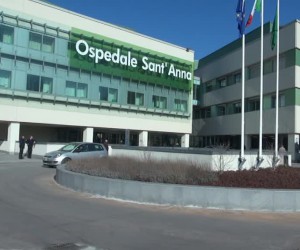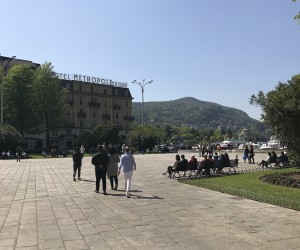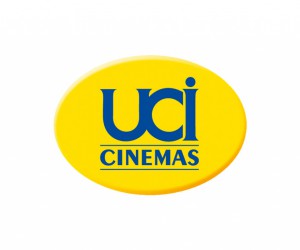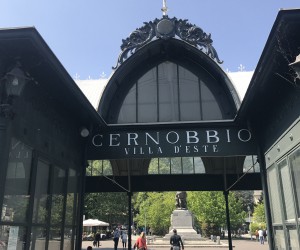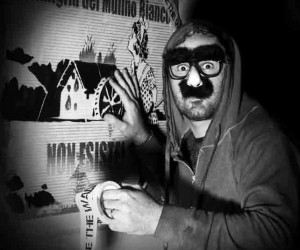
| THE AWARD |
| CATEGORIES |
| REGISTRATION |
| SUBMIT YOUR WORK |
| ENTRY INSTRUCTIONS |
| TERMS & CONDITIONS |
| PUBLICATIONS |
| DATES & FEES |
| METHODOLOGY |
| CONTACT |
| WINNERS |
| PRESS ROOM |
| GET INVOLVED |
| DESIGN PRIZE |
| DESIGN STORE |
| THE AWARD | JURY | CATEGORIES | REGISTRATION | PRESS | WINNERS | PUBLICATIONS | ENTRY INSTRUCTIONS |
Travel Guide |
Home > Resources > Travel Guide |
Welcome to the A' Design Award and Competition's Travel Guide: Como. We have prepared this guide to help our laureates travel to Como, Italy to attend our Gala-Night and visit our exhibition, as well as enjoy the City and its amenities, landmarks, districts and life.
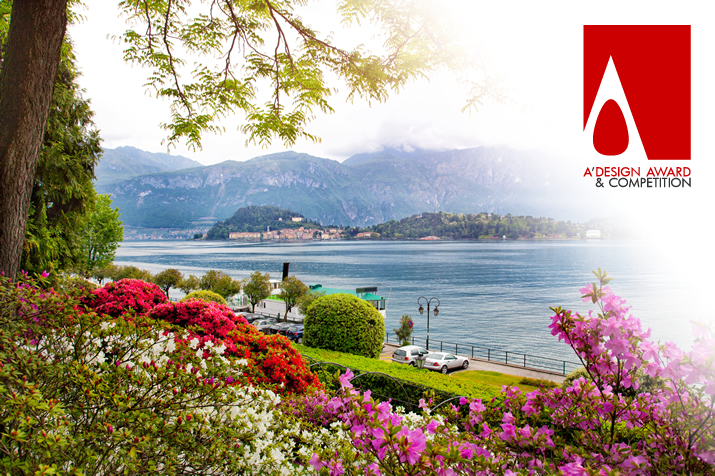

Important Information
Important Information Regarding The Travel Destination: Maps, Key Details and Other Points of Interests
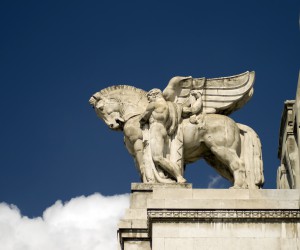
Travel from Milano to Como and Como to Milano Important Information
There are three practical ways to travel from Milano to Como based on where you are. If you are at Malpensa Aeroporto, then you will want to take the train from Cadorna to Como Lago. It takes about 50 minutes and it is really cheap. If you are in Milan City, you can take train from Cadorna to Como Nord Lago or you can take train from Stazione Centrale to Como S. Giovanni, this is a different train station but it is also near the lake, and it is also cheap, but if you miss your stop, you can find yourself in Switzerland but the Como Nord Lago last stop is the lake so perhaps more safe for you if you do not have a multiple entry visa! Then, the last option is to take a TAXI. Now when coming to Como, it might seem expensive; but when returning from Como, you will find it quite useful, because in the night, there are no trains, and even though the taxi costs 120 Euro it can be cheap; if you take 4 person, that would be about 30 Euro each, and you can go to Milan any time back, otherwise of course you could decide to stay in Como in a hotel. Finally, the last option would be to rent a car, which could also make sense if you like to travel around, that would costs maybe as much as a single taxi drive, the parking in Como is usually problematic, but near Villa Olmo, you will find a good parking place but of course it might already be full at night!
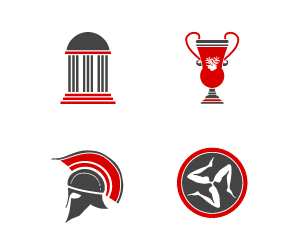
Museum
Museums, Cultural Centers, Heritage Locations and Libraries
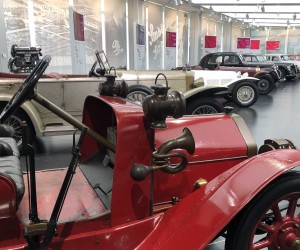
Alfa Romeo Museum Museum
This is a really nice museum if you like cars, there are many vintage cars, and overall it is a great experience. You can find cars from all time periods. There is a nice museum shop and a coffee bar. There is also a 4D cinema (kids below 6 not admitted). Museum is several floors, its architecture is nice. It is usually not busy. A lot of opportunities to take some nice and cool photos with cars. Entry is not free but not expensive either. There is ample parking available.
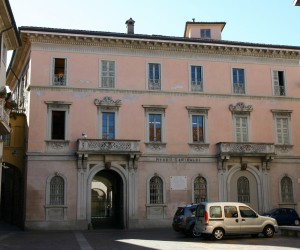
Museo Storico Giuseppe Garibaldi Museum
The History Museum "Giuseppe Garibaldi" has an incredible collection of costumes and textiles of the 18th and 19th centuries. The museum exhibits the items of Risorgimento era that includes ceramics, manuscript and medals. Highly recommended: the Angelo Trezzini's painting "A hunter of the Alps", 1860 approximately, oil on canvas.
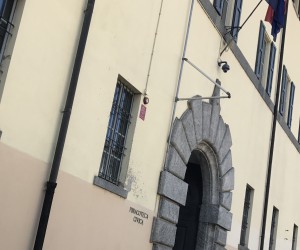
Pinacoteca Civica Museum
Palazzo Volpi's Pinacoteca is one of the four sites of Como's Civic Museums. It was a noble residence of the Volpi family and then of the Canarisi family until the middle of the nineteenth century, when it was bought by the state, which destined it to the court of justice, unfortunately sacrificing the garden to build the Carceri. Delivered in the seventies of the twentieth century to the Como, it was then restructured and prepared to become a museum site. The visit of Palazzo Volpi is the ideal starting point for getting acquainted with the artistic reality of the city and the area.
Highly recommended: S. Margherita's Master "SS. Faustina and Liberata's History", second decade of XIV century, fresco from S. Margherita's Convent in Como.
Highly recommended: Antonio Sant'Elia: "Multilevel house with external elevators", 1914, black pencil and orange pastel.

Museo Archeologico Paolo Giovio Museum
The archaeological museum Paolo Giovio di Como, historically known as Palazzo Lucini, was first inaugurated in 1897, with the surname of the homonymous family Comasca, with its seat in the Medaglia d'Oro 1 square.
Includes the following sections: the collection section, the prehistoric protostorical section, the Roman section, the medieval section and rich library.
Highly recommended: the Egyptian hall, the gem hall, the Greek vases hall and the Archaeological finds of Lake Como.
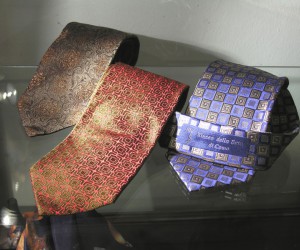
Museo Didattico della Seta Museum
The Educational Silk Museum treasures, collects and displays machines, objects, documents, samples and instruments witnessing the glorious past of the textile industry that still nowadays rewards Como as the “City of Silk”.
Moreover, its technical and artistic heritage is arranged in an easily accessible building.
The love and passion for silk have ancient origins and have also been consolidated by the local Camera di Commercio, Provincia and Comune di Como since 1866 through the organisation of professional courses for textile operators.
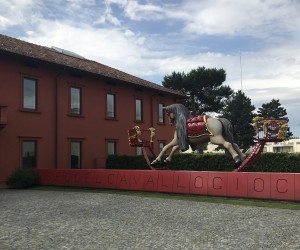
The Toy Horse Museum Museum
The Toy Horse Museum is the one and only museums in the world dedicated to toy horses The Museum is hosted in what used to be the stables of Tornese, a famous, several time world-champion trotter in the 1950s. In 1969, Pietro Catelli, founder of Artsana Group and "Cavaliere del Lavoro" for his merits as an enterpreneur, purchased the building and surrounding land to establish the Artsana headquarters. On 14 April 2000, on the occasion of his 80th birthday, he decided to leave a unique gift to his company and local community by inaugurating the Museum, which hosts his collection of toy horses in the historical stables that once belonged to Tornese.
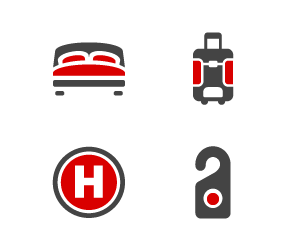
Hotel
Hotels, Motels and Boutique Accomodation
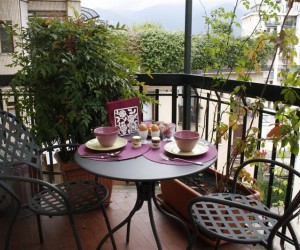
La Rondine B&B - Como Hotel
The brand new B&B La Rondine Como is located in the heart of Como, in an ideal and strategic position. A point of departure to discover the wonders of the Lake of Como and many more.
This entirely new house is equipped with every comfort and offers three different accommodations, featuring a modern and elegant design: two flats are equipped with en suite bathroom/services and one with external bathroom/services for exclusive use with a total of 6 beds.
The B&B La Rondine Como offers the cosy warmth of a real home and is suitable for all types of customers, from the curious tourist and families on vacation to the businessman/woman and the groups of friends….
The B&B La Rondine Como is just seven minutes' walk from the S. Giovanni Station of Como (from which you can reach the Central Station of Milan in 35 minutes by train) and can be an excellent overnight solution for those who after a busy day in Milan (as it could be the case during the upcoming Expo 2015) want to return to a more relaxed and friendly atmosphere in Como.
Should you prefer a complete privacy you can ask for the exclusive use of all rooms including the kitchen (see under menu Rooms /services, Flats).
At B&B La Rondine Como, we also speak English and French.
The rooms are all equipped with adjustable air conditioning, Wi-Fi free, LCD TV, safe for PC and hairdryer. The refrigerator in the kitchen can be used in common.
The bed-rooms are three, they are entirely new, maximum two adults per room.The bed-rooms have different characteristics, twoo bed-rooms have private bathroom inside, the third room has a double sofa bed and it has bathroom just outside but it is for the exclusive use.( It is not shared with ather guests).
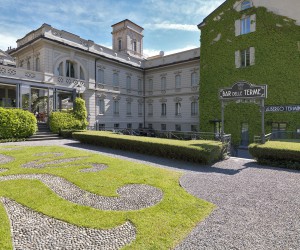
Hotel Terminus Hotel
The Hotel Terminus was born of the complete restructuring of an early 19th-century palazzo, whose Liberty style and tasteful elegance, typical of the Lombard aristocracy, has been artfully preserved.
In addition to revitalize the splendid architecture of the historic edifice, the restoration has radically reconfigured its infrastructure and service facilities in order to ensure maximum comfort and convenience for our guests. Welcoming you to the hotel is the Hall and its magnificent loggia. Here, every detail is original, from the banisters and cast iron lamps to the delicate stucco work and charming 19th-century Lombard paintings on the walls. The Hall provides access to the restaurant, located on the same floor, and to some of the guest rooms as well. It is also set up for WiFi connection. The Reception Desk is available to you at all times for anything you may need: air and train tickets, taxi service, currency exchange, tourist information, fax and Internet service. For more specific requirements, you can ask the duty manager at any time of day or night. Otherwise, just make yourself comfortable in the luminous reception lobby and enjoy a quiet moment of relaxation.
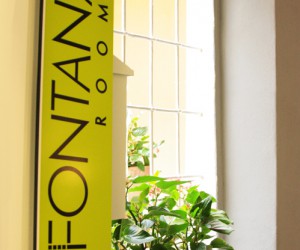
Fontana Rooms Hotel
Housed in one of the historic buildings in the centre of Como, Fontana Rooms is the ideal solution for those who love the tranquillity of the old city but at the same time want to experience the area starting from its heart. A stone's throw from the lake and Duomo, its strategic location makes Fontana Rooms accessible in just a two-minute walk from the lake front, 10 minutes from both the FFS and FNM railway stations and the same from the central bus station.
The cable-car to Brunate from where you can enjoy stunning views over the city and the lake, is 15 minutes away on foot. Brunate is also an excellent starting point for many mountain trails. If you are feeling more adventurous, you can try your hand at flying, or simply enjoy the spectacular views from one of the seaplanes that take off from the Hangar on the lake front just 10 minutes from the hotel.
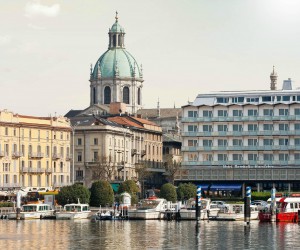
Hotel Barchetta Excelsior (10% Discount) Hotel
A refined, modern and quiet environment. The rooms, enriched with fabrics and furnished with beige and green colour tones, are now more pleasant and functional to live in, for both our business and leisure clientele.
The sixth floor is an executive floor: 1 suite with separate lounge and two bathrooms and 3 junior suites with adjacent living space, large terraces open the magnificent view onto the cathedral or the lakefront. Technological comfort, wi-fi available in all the hotel.
Christian Babuin is the chef of our Restaurant “Bistrò”. After an important professional experience at the Four Seasons Hotel in Milan, Christian brings to the heart of Como a traditional regional cuisine, with a magical touch of lightness and modernity. Simple and light proposals for a quick lunch and a more elaborate menu for dinner.
Elegant and comfortable spaces, an impeccable service and a renewed cuisine, make this hotel in the centre of Como, the Italian capital of silk and crossroads of the best Italian craftsmanship, the right place to be in town.
Whatever the purpose of your stay, whether it be for business or for pleasure, the Hotel Barchetta Excelsior, managed by the Villa d’Este Group, gives you a very warm welcome!

Albergo del Duca Hotel
Situated in the City center of Como, in the splendid walled City. Family management and modern comforts.
Latest restoration of the building, the evocative location of the Hotel offers relax and serenity to clients. Albergo del Duca is Family management with modern comforts. The inauguration was on April 2004 and is the ideal choice for a holiday or working travel. All the rooms are soundprooved and equipped by air conditioning, mini-bar, TV, telephone, free WiFi, air drier and save deposit box.
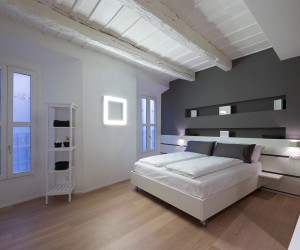
Como Luxury Rooms (Trade Discount 5% Off) Hotel
Como Luxury Rooms is new. Finished and furnished in March 2015.
The hotel offers its guests spacious and soundproofed rooms, bright and modern with a private bathroom. Equipped with all the extras such as air conditioning and underfloor heating, mini-bar, safe, SMART TV FULL HD Satellite 42 ", Wi-fi and free unlimited internet access with Fiber Optics, professional hairdryer, courtesy kit and large shower room.
Como Luxury Rooms will make you sleep sweet dreams thanks to the brand new mattresses of last generation and you can choose the hardness (stiffer or comfort) at the time of booking.
On arrival in the rooms you will find a Welcome pack (if you book through website). Herbal teas and espresso (thanks to the Nespresso machine supplied in rooms) will always be present in your rooms.
For breakfast you can choose between many bars of the street that will delight you with tasty pastries and local flavors.
Service available in the breakfast room, on reservation.

Restaurant
Restaurants, Takeaways, Food Courts, Places to Eat, Fine Dining
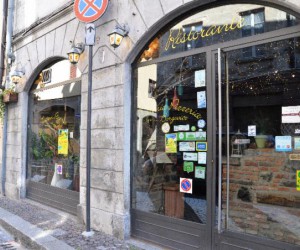
Trattoria Pizzeria Restaurant Borgovico Restaurant
Trattoria Pizzeria Restaurant in Borgovico is a pizzeria restaurant in Como that offers its customers delicious fish dishes, delicious grilled and all the specialties with Mediterranean flavors.The recipes proposed to customers are inspired by all the typical dishes of the Mediterranean tradition and thanks to the presence of skilled chefs every dish is cooked to perfection, with genuine ingredients and always fresh. Great attention is paid to the quality of raw materials, always trying to create original and tasty dishes.
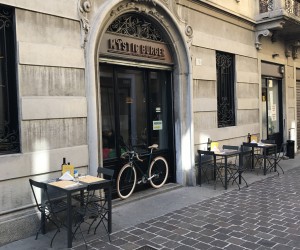
Mystic Burger Restaurant
The mystic burger as its name suggests is a true mystical experience of taste where different flavors come together in one sandwich. All the products are of the highest quality and fresh from the bread made with the antique cereals to the artisan cheese and meat.
The menu consists of 6 sandwiches all details, in fact it goes from the fish burger to the vegetarian, to the classic burger.
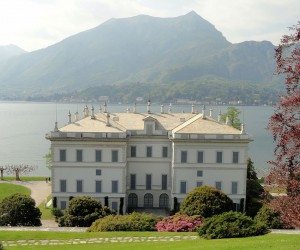
Villa Melzi Gardens Restaurant
The Gardens of Villa Melzi strech out along the lake shore and are armoniously inserted into the hilly scenery of the Bellagio peninsula that divides the two branches of Lario lake. Inland, the Villa, the Chapel and the orangery, today transformed into a historical museum, are splendid expression of neo-classical style and as such stated national monument.
This architectural complex was realized between 1808 and 1810 for Francesco Melzi d'Eril (1753-1816), Duke of Lodi, Vice President of Italian Republic under Napoleon and afterwards Gran Chancellor of the Napoleonic Reign of Italy. The Japanese garden and the monument to Dante and Beatrice of G.B. Comolli are in front of the Villa and the flight of steps of the Azaleas are in front of the Villa, with its semicircular terrace which communicates with the lake through a system of stairs.
Many interesting sculptures are in the most splendid park, where stupendous groups of azaleas ad rhododendrons alternate. On the left of the entrance, in the cave, there is an Etruscan cinerary urnof the 3rd century B.C., which comes from the graves of the Scipioni in Rome. Further on, by the small lake of the Nympheas, there are two Egyptian sculptures of the XVII and XIX dynasty which represent the lioness goddess Sekhmet and made from basalt and a statue-cube.
From April to October daily 9,30 am to 6,30 pm (last entry at 6 pm) closed November to March. Cost: 6.5 euro
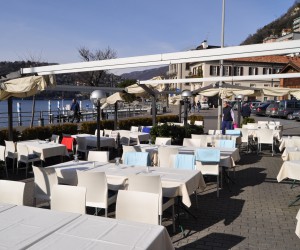
Ristorante Funicolare Restaurant
Placed in front of the beautiful Como Lake, the Ristorante Funicolare is located right next to the Como Cable Railway that goes to Brunate. The view of the restaurant is exceptional, it sees the Como lake, and it features both lake side tables as well as a closed but with glass covered section if you choose to get a table inside. Ristorante Funicolare is good for seafood, but they also serve steak, pizza and other Italian specialities such as risotto and of course the local Polenta. You can choose among 40 types of pizza, but actually their seafood is quite delicious. Ristorante Funicolare is a family owned business therefore you will enjoy a warm environment. The restaurant has been serving clients more than 20 years, and it is not expensive, for two people it could cost about 30 euro if you take a pizza, including drinks and coffee.

Landmark
Landmarks, Important Buildings, Historical Buildings
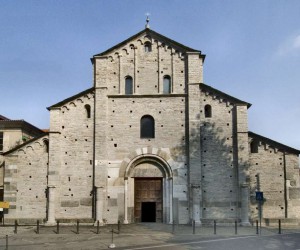
Basilica of Sant'Abbondio Landmark
The Basilica of Sant'Abbondio rises outside the walls of Como, under the Monte Croce, along a stretch of the Via Regina which is an important area of worship due to the presence of some Roman necropolis and, from the 5th century, of the Church of Saints Cosmas and Damiano and of the Basilica apostolorum. During the ninth century the church assumed the dedication to St. Abbondio, which was buried four centuries before; however, it has now been excluded that it was the seat of the bishop of Como, as instead a long thought by some voices of the local historiography.
In 1010 the bishop of Alberico installed a community of Benedictine monks near the basilica, which soon reached a prominent position in the diocese thanks to the recognition of public and ecclesiastical powers and a substantial patrimony. The trades began the reconstruction of the basilica: demolished the early Christian structure, the church was better built in Romanesque forms and consecrated by Urban II in 1095, but important interventions were promoted in the following two centuries, with the construction of an atrium porticato a shelter of the facade - probably dedicated to pilgrims - and, in the fourteenth century, with the pictorial decoration of the apse.
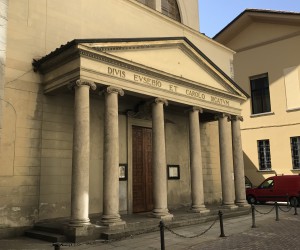
Chiesa di S. Eusebio Landmark
The area around the church of S. Eusebio preserves traces of buildings that date back
At the low empire Roman; Just remember the Musso marble blocks with friezes that are
Discovered in the nearby Cinque Giornate street.
That the present church of St. Eusebius, to be attributed to the XII century, is confirmed by the
Left perimeter walls, typically worked like Romanesque apses, with stones
Square and with slit openings, from the bas-relief of Saint Eusebius outside and from an ancient
Parchment of April 14, 1186, which clearly appoints the church.
The ancient facade of the Romanesque church was not turned towards Via Volta, but towards the walls,
Towards the present Varese Avenue: the church's orientation was therefore that fixed by the canons
Of the time: apse to the east, facade to the west. The acts of the pastoral visit of the bishop
Feliciano Ninguarda in 1592 tell us about a mediocre church with three naves,
Devoid of bell tower, with a baptistery in various marbles. The bishop, detected the inconsistency
Of a provision that closed the view of the façade to the faithful, ordered that he be transferred
Greater facade on the public road.
In the sixth-eighteenth century many works were performed: the arrangement of the
Church and altars were rebuilt. In the early nineteenth century the church was enriched outside
A pronaos with Ionic columns by architect Magistretti. In 1805 the parish was
Suppressed by Napoleon and the church became Vicar of the Cathedral. Subsequently, the 1st
January 1931, Bishop Macchi reconstructed her again in parish. In 1933 it was
Built the bell tower on a project by architect Zanchetta. The dedication also to
Saint Charles, on the front of the facade dates back to 1934.

Baradello Castle Landmark
The castle occupies the ancient site of Comum Oppidum, the original settlement of Como, dating from the 1st millennium BC. Later it was one of the last Byzantine strongholds in the area, surrendering to the Lombards in 588. The castle was restored during the War of the Lombard League, with the help of emperor Frederick Barbarossa (1158). Barbarossa officially donated it to the citizens of Como in 1178.
Napoleone della Torre died here in 1278, having been imprisoned here by Ottone Visconti after the Battle of Desio; his nephew Guido was able to escape in 1283, as well as his brothers Corrado and Enrico the following year. Azzone Visconti restored and enlarged the fortification after conquering Como in 1335, and built another castle, the Castello della Torre Rotonda ("Castle of the Round Tower", now lost) and a citadel.
In 1527, by order of emperor Charles V, the castle was dismantled, with the exception of the tower, to prevent it from falling in hands of the French troops that had invaded the duchy of Milan. After belonging to monks and then to private individuals, the castle was restored in 1971.
The most preserved element is a square tower, measuring 8.20 m × 8.35 m (26.9 ft × 27.4 ft) at the base, and standing at 27.50 m (90.2 ft). It once had Guelph-type merlons. The walls are of Byzantine origin (6th-7th century); these were later heightened and provided with Guelph merlons, while another external line of walls was added. Also from the 6th century are the Chapel of St. Nicholas and quadrangular tower (4.40 m × 4.15 m (14.4 ft × 13.6 ft) at the base), which was used as the castellan's residence. Napoleone della Torre was buried in the Chapel of St. Nicholas.
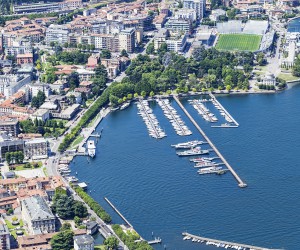
Stadio Giuseppe Sinigaglia Landmark
The stadium "Giuseppe Sinigaglia" is the main football stadium in the city of Como. It is located on the lakeshore, between Voltiano's gardens and the Aero Club Como hangar; Near the central tribune is the Novocomum building and in front of the distinctive sector is the Canottieri Lario.
It was realized at the wish of Benito Mussolini and the project was edited by architect Giovanni Greppi. His construction was one of the first examples of rationalist architecture in Italy and is titled for the rocket champion Giuseppe Sinigaglia who fell in the First World War.
The stadium is the property of the Comune di Como and during the league matches it is leased to the soccer club Calcio Como.
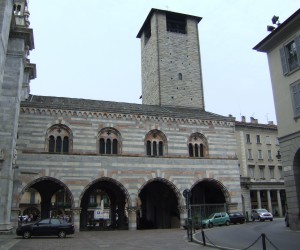
Broletto Landmark
Attached to the cathedral is the Romanesque-Gothic Broletto dating back to 1215, the center of political and economic life of the city. It was destroyed several times in moments of heightened tension between the Como factions.
It was renovated by the nobility of Como and opened as a theater in 1765. He was a living hero of many skirmishes between the aristocracy and the commoners. Many dances which where held at Today the Broletto houses exhibitions.
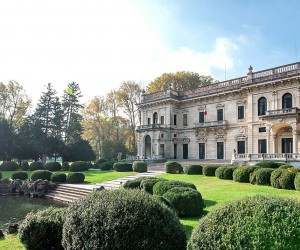
Villa Erba Landmark
Villa Erba, architectural jewel of the XVIIIth century, was once the summer residence of the “Erba” family. Here, the great director Luchino Visconti, spent many of his summers and the rooms of the villa inspired the sets of some of his most famous masterpieces. Today the villa, with its ancient frescoes, the precious inlaid ceilings andMannerist rooms, is the ideal location for unique events. At Villa Erba, prestige and worldliness live in perfect harmony: from the most formal conventions to the wildest of parties, where music is guaranteed until late at night thanks to the ideal location of the villa away from populated centres, every event is unique.
A lake, a park, an historic villa and a conference centre: only at Villa Erba can you find all of this within one single location. Only at Villa Erba, the versatility of the facility and the functionality of the spaces allow you to organize events of any kind, different from each other and which can be developed either individually in one of the areasavailable or simultaneously throughout the whole facility. To allow for maximum customization, all surfaces are provided empty and do not have standard equipment: there are no constraints, only imagination and creativity. Villa Erba, architectural jewel of the XVIIIth century, was once the summer residence of the “Erba” family. Here, the great director Luchino Visconti, spent many of his summers. The rooms of the villa have inspired the sets of some of the directors greatest masterpieces. Today the villa, with its ancient frescoes, the precious inlaid ceilings and Mannerist rooms, is the ideal location for unique events. At Villa Erba, prestige and worldliness live in perfect harmony: from the most formal of conventions to the wildest of parties (where music is guaranteed until late at night thanks to the ideal location of the villa away from populated centres), the only
limit is imagination.
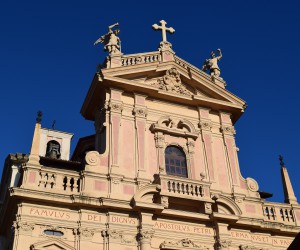
Chiesa di Sant Andrea Brunate Landmark
According to a tradition, the primitive building arose in the years around 1340 when Elena and Andreola Pedrali retired to a land of their property near a chapel and founded a monastery dedicated to Sant'Andrea. Documents testify to the existence of this monastery and the foundation of the church in the previous era: in 1300, according to some, still before the second (in 1246 the Milanese abducted the abbot of Sant'Abbondio and led him through the forests of Sant'Andrea - It is not quite clear whether this location should be identified with Brunate). Probably, though, a place of worship had to exist in the 6th century.
The original construction, however, underwent modifications and extensions over the centuries: early works are documented in the fifteenth century following the intervention of Blessed Maddalena Albrici; Subsequently, in 1654, by order of the bishop of Como was almost completely rebuilt and in subsequent years were the decorative interventions that affected him. In addition, between 1927 and 1932, a central body was added to the west due to the considerable increase in the number of the faithful.
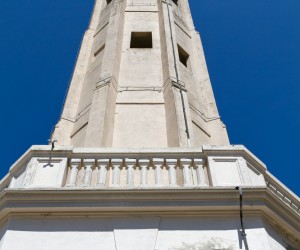
Lighthouse Brunate Landmark
Starting from Piazzale of Brunate funicular you can take a beautiful walks. In a few minutes you get to the source of Pissarottino, vantage point from which you can admire the fist basin of the lake, Villa d'Este, Villa Olmo and Monte Rosa.
It is possible to walk to Como following two paths: one that runs along the Funicular an the other, very impressive, that passes through the Hermitage of San Donato (former convent of the XV century).
Those who want to climb from Brunate, can reach San Maurizio or the Cao with the bus and walk from there to where you like.
Another recommended excursion is Piatto Mountain,
The Volta lighthouse was erected in 1927 as well as the Volta Temple, on the centenary of Volta's death and to celebrate the recent advent of a modern network for lighting and for the diffusion of electricity in the city of Como. The lighthouse designer is the engineer Gabriele Giussani. The tower, with octagonal base, has a height of 29 meters and inside has a spiral staircase of 143 steps leads to the summit. From the top you can admire the Como area, the first basin of Lake Como and range up to see the view of the Alps; in the night, the light of the Volta light is visible up to fifty kilometers away.
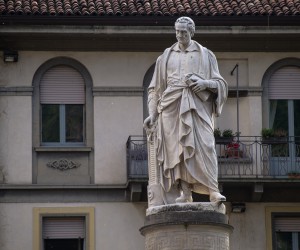
Monumento a Alessandro Volta Landmark
Monumento a Alessandro Volta was inaugurated in 1838 by Pompeo Marchesi, one of the most famous sculptor of that time. The pedestal built by Francesco Durelli and a simple dedication is engraved above the sculpture: "A. Volta - La Patria "

Teatro Sociale di Como Landmark
Teatro Sociale di Como is a focal point for the cultural life of the area. It attracts opera fans in particular from a large triangle whose corners are formed by Varese, Lecco and Switzerland. Since 1 January 2002, the performances and all the opera house’s activities have been managed by AsLiCo (Opera Concert Association) of Milan, while the building is owned by the Gallery Ticket Holders’ Society.
Teatro Sociale was founded in 1813, the year Giuseppe Verdi and Richard Wagner were born. It was built in an area known as the “place of ruins” because it was the site of the Castle of the Round Tower, dating from the second half of the thirteenth century. The project for the purchase of the area was promoted by Count Giampietro Porro, chairman of the committee for the new opera house and Podestà of Como. The design of the opera house was entrusted to the architect Giuseppe Cusi and construction commenced in 1811. The curtain went up for the first time on the evening of 28 August 1813, on Antonio Fonseca Portugal’s Adriano in Siria and Giuseppe Mosca’s I Pretendenti Delusi.
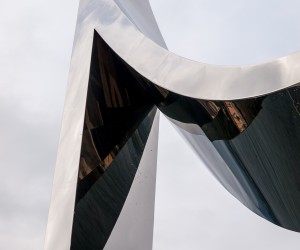
Life Electric Landmark
Life Electric is a monument conceived and designed in honor of the great Como scientist Alessandro Volta. It stands at the center of the first basin of Lake Como, located in the end portion of the breakwater in front of Piazza Cavour. The work is star architect Daniel Libeskind: clean, linear, deeply contextualized environment. High about 13,75 meters (14,25 from the ground), the shape has sinuous movements.

Villa Gallia Landmark
Villa Gallia is a very nice place in front of the lake, It is the oldest building in Via Borgovico. It was built as a summer residence in 1615 by Abbot Marco Gallio , nephew of Cardinal Tolomeo Gallio. The building , owned by the family until 1772, is now owned by the Province of Como.

Basilica San Fedele Landmark
The Basilica of San Fedele in Como is located in the city center and is dedicated to Saint Fidelis martyr. It derives from an earlier Christian church, dating from the seventh century, dedicated to Euphemia.
The magnificent Romanesque Basilica of San Fedele in Como was built around 1120 on early medieval foundation. The Basilica features the charming Piazza San Fedele was a medieval commercial center and famous grain market. The church contains fragments of frescoes from the fourteenth century and paintings of the sixteenth and seventeenth century.
Important historical pole of the walled city, ancient seat of the market of the grain. On the public square two houses of the XVI century that have overhanging porchs, wooden and bricken structures disposed like fishbone, according to a constructive technical of Nordic origin.
Masses are celebrated
in the days Weekdays: 8:30 am 6:00 pm
Holidays days: 8:30 am 10:00 am 11:15 am 06:00 pm
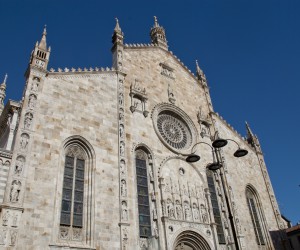
Chiesa Cattedrale di Como Landmark
Como Cathedral is dedicated to the Virgin Maria. It is the biggest Cathedral in Lombardy after Duomo of Milan and The Certosa of Pavia.
The Architecture of Cathedral dominates the historic center of Como, it was begun in 1396 and is the last of the Gothic cathedrals built in Lombardy. It took three and a half centuries to construct and has a late Gothic-Renaissance style.
The dome was designed by Philip Juvara (1687-1736), architect of the King of Sardinia. The windows are from nineteenth century and were created and designed by Joseph Pompeo Bertini. Among the many works of art that adorn interior, there are sixteen century tapestries, paintings by Gauedenzio Ferrari, Bernardino Luini, Morazzone (XVI-XVII century), as well as frescoes in the sacristy (built in the fist half of the seventeenth century), and sculptures of Rodari.
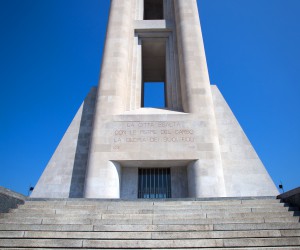
Monumento ai Caduti Landmark
Monumento ai Caduti is an imposing tower, 30 meters high, opened by large windows and completely covered in Aurisina and Reppen stone. The Monument was built by Giuseppe Terragni, rationalist architect, on 4th November 1933.
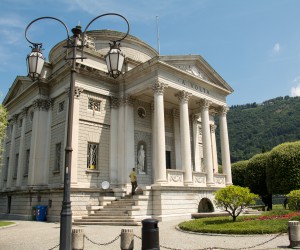
Tempio Voltiano Landmark
The Tempio Voltiano is a museum in the city of Como, that is dedicated to Alessandro Volta, a prolific scientist and the inventor of the electrical battery. Volta was born in Como in 1745, held his first professorship there until 1779, and retired to Como in 1819.
The neoclassical building was designed by Federico Frigerio (1873–1959). It was completed in 1927 to celebrate the 100th anniversary of the scientist's death, but it was inaugurated only in 1928. It hosts a collection of scientific instruments used by the physicist including his early voltaic piles (batteries). The first floor has a display of his personal belongings and his awards. It is one of the most visited museums in town. The temple was featured on the back of the 10,000 lire banknote, while Volta's portrait was depicted on the front of the same banknote. Banknotes based on the Italian lira have since been replaced by notes denominated in Euros.
The Electrophorus and capacitors are also on display. It was the cotton farmer Francesco Somaini, a designer, developer and construction lender, who wanted the building worthy of the great scientist. He wanted to have high scientific value and great documentary content and also for the building to be monumental and add new luster to the city. Architect Federico Frigerio designed the temple vault, which emulates the Pantheon.
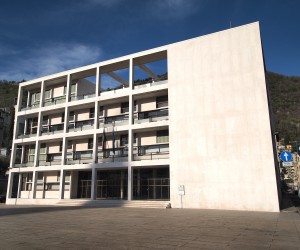
Casa del Fascio Landmark
Casa del Fascio, casa Littoria, or casa del Littorio was a building housing the local branch of the National Fascist Party and later the Republican Fascist Party under the regime of Italian Fascism. In major urban centers, it was called the palazzo del Littorio or palazzo Littorio. Littorio means lictor, the bearer of the fasces lictorii, the symbol of Roman power adopted by the Fascist party.
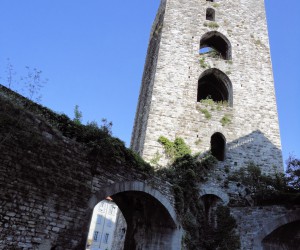
Porta Torre Landmark
The walls of Como surrounding on three sides the city center, are still well preserved for 70% of the original perimeter and date back to the medieval period. They were built, for the first time, at the initiative of Julius Caesar, in the first half of the first century BC about 20 meters within the structures visible today. These principals were part of a complex defensive structure intended to cover access to Milan and the Po valley from the central Alps, which included, among others, the Castel Baradello, the Comacina Island fortifications, the hole structures of lead and primitive fortresses of Bellinzona .
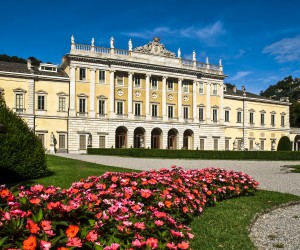
Villa Olmo Landmark
Villa Olmo is a neoclassical villa located in the city of Como, northern Italy. Is the most celebrated and sumptuous of the historic homes of Como and one that made Como one of the driving forces of Enlightenment in Italy. Simone Cantoni succeeded in realizing the needs of a cultured and progressive aristocracy, bringing good taste to those buildings "remodelled in the modern fashion" while fully embracing the ideas of the Enlightenment at time that saw Lombardy, and Milan in particular, become one of liveliest center in Europe.
In the words of academic Nicoletta Ossanna Cavadini, it was a true "philosophical world" based on the proportions of the golden section.
The architect was in tune with the personality of the principal Marchese Innocenzo Odescalchi who returned from Rome in 1780 with an up-to-date and cosmopolitan education and committed himself to a program of cultural renewal of the whole Como area, including the construction of a suburban villa in line with the reforming ideas of the enlightened thinkers.
Villa Olmo is owned by the municipality of Como. They organize many art exhibitions.

Sightseeing
Sightseeing, Good Views, Natural Wonders, Bellavista

Isola Comacina Sightseeing
This is a fun little island with beautiful landscape, good for walking and hiking, features a nice but expensive restaurant, entry to the Island is subject to a fee. The restaurant is particular, features a fix menu, and a performance which takes place at the same hour same day. Many people, in summertime, take their boats to the island to sunbathe and swim. There is not much to see historically, except for a church, however it still is a great fun time for those who like nature and travel.
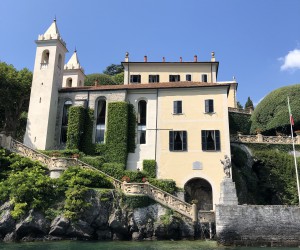
Villa del Balbianello Sightseeing
Mostly renown as the villa in planet Naboo in Star Wars Episode II: Attack of the Clones, where Anakin kisses Padme for the first time. The villa has a very nice, well maintained garden with exceptional view of the lake and mountains. You can take a guided tour to learn about its history (the tour takes an hour). There is no coffee or bar, so make sure to drink or eat before you arrive or you could also enjoy a fine lunch in Lenno. What is also remarkable is that to arrive to the Villa del Balbianello you will indeed enjoy very beautiful sightseeing, either by boat or by car, you will enjoy finest Como Lake landscape.
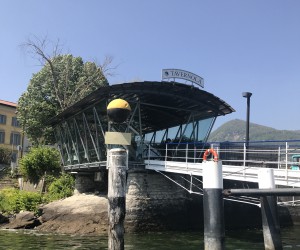
Tavernola (Como) Sightseeing
Tavernola è una piccola frazione situata nel comune di Como. Situata nella zona nord del comune, è la prima frazione lacustre della sponda occidentale del ramo di Como dell'omonimo lago. Confina con le frazioni di Ponte Chiasso, Sagnino, Monte Olimpino e con i comuni di Cernobbio e Maslianico.
Tavernola is a small hamlet located in Como. Located in the northern part of the municipality, it is the first lakeside part of the western shore of the Como branch of the same lake. It borders the villages of Ponte Chiasso, Sagnino, Monte Olimpino and the municipalities of Cernobbio and Maslianico.
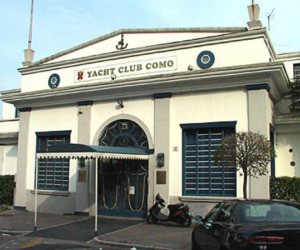
Yacht Club Como Sightseeing
The Yacht Club Como is located in the city center of Como and is in front of a modernly equipped marina.
Numerous and other levels the services offered to the members: bar, restaurant on lake terrace, swimming pool, gym equipped with the possibility of making personalized training programs, sauna and Turkish bath.
Particularly active social life, which includes numerous cultural or thematic evenings, and a section dedicated to young people.
The two sports, sailing and Motonautica sections, guided by the respective directors, carry out pre-event activities, racing and Motonautica competitions throughout the year.
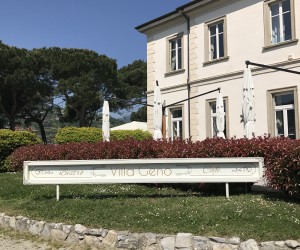
Villa Geno Sightseeing
Villa Geno is located in the heart of Como, alongside the famous fountain with a jet of water 30 meters high, and it is set in a unique natural complex consists of the Lake and the promontory behind.
A charming Villa full of history for an unforgettable event.
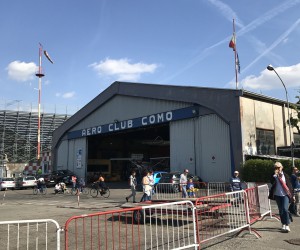
Aero Club Como Sightseeing
Since the times of the Italian aviation, the Idroscalo di Como has been a reality of primary importance, institutionalized in the national and international airport system in the thirties.
In fact, on the Idro Scalo of Como, where frequent seaplanes have been operating since 1913, has been flying continuously since the spring of 1930.
Aero Club Como, founded on April 6, 1930, is a non-profit, non-profit, amateur sports association with legal personality and federated at the Aero Club d'Italia and then by CONI, as well as various industry associations Of civil aviation.
His status and activities are governed by a Statute, which is drawn up on the basis of the Statute-type of clubs federated at the Aero Club d'Italia.
The object specified in the statutes includes many activities, the main being those of the flying school, the maintenance of a structure that makes seaplanes available to members and the promotion of aeronautical and flight culture.
These activities are, in the case of the Aero Club Como, of extreme pride, being the only club in Italy that operates with seaplanes and therefore the only depository of the technical, operational, administrative and regulatory culture connected.
The club is headed by Giuseppe Ghislanzoni, a comic pilot who fell in the First World War.
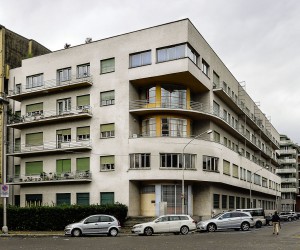
Novocomum Sightseeing
Giuseppe Terragni designed from 1927 to 1929 the Novocomum, a modern apartment complex. He presented a proposal with very traditional sides to the municipality, which they approved. The scaffolding was placed and construction was started. However, the construction drawings which were presented to the municipality have never been received by the builders, which he gave a new proposal. Nobody could see what was developing behind the scaffolding. At the moment of presenting the finished building, it was a big shock. An awful building had risen up, according to the municipality. There was even a moment they considered demolishing it, until they realized that the avant-gardists loved the building and it made Como an even more popular destination. Terragni was looking for a good combination between surrounding landscape and the building. This Rationalist thinking ended up in a well-designed apartment complex.
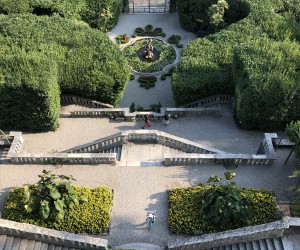
Villa Carlotta, Tremezzo Sightseeing
Villa Carlotta is one of the most famous villas around the lake, a place of rare beauty, where masterpieces of nature and art live together in perfect harmony in over 70.000 square meters of garden and museum. The building was erected around 1690 by marchese Giorgio Clerici. In 1801 Gian Battista Sommariva, famous politician, businessman and patron of arts, bought the villa. Thanks to this owner the property in Tremezzo attained the summit of its splendor and became one of the most important halting-place of the Grand Tour. The villa became a temple of XIX century art with works of Canova. Thorvaldsen and Hayez: Palamedes, Eros and Psyche, Terpsychore. Under Sommariva part of the park was transformed in a fascinating romantic garden. Sommariva's heirs sold the villa in 1843 to Princess Marianne of Nassau, Albert's of Prussia wife, who gave it as a present to her daughter Carlotta, during her wedding with Georg II of Saxen-Meiningen. Inside the beautiful garden you will find the "Ingresso di Alessandro Magno a Babilonia" by Berthel Thorwaldsen, built between 1817 and 1828; "The last kiss of Romeo and Juliet" by Francesco Hayez; "Amore e Psiche" by Adamo Tadolini in 1824, and more. Is possible visit the beautiful garden during all the year, multiplicity flowers: Camellias, century old Cedars, Sequoias, Tropical plants and more. The magnificent park revokes the Romantic period, garden with geometrical shape, fountains, old trees of big size and views of great charm. The Villa Carlotta's park is about 8 hectares, a place where you can spend a lovely day and lose yourself in the fascinating nature.
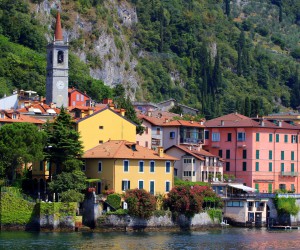
Varenna Sightseeing
Varenna, terminus with Cadenabbia of the ferryboat service for vehicles from Bellagio, its situated on a promontory at the mouth of the Esino stream. The center is structured according to the design lay-out of Ancient Rome. The village was fortified in the Middle Ages and its town-planning and buildings of unique value are still preserved. Here there are two tall villas nearby the church of San Giorgio of the 14th century, later re-elaborated in the 17-18th century.
The Tourist Information, called the Proloco Varenna Information Point, is on the main square. It's generally open during high season from May to September, from 10 to 12 and 3 pm to 6 pm on Tuesday trough Saturday, and 9 am to 12 am on Sunday (http://www.discovervarenna.com). There is a travel agency at one block from the train station. It's good backup when Tourist Information Point is closed. The travel agency is also handy to buy train tickets, as the small train station has no ticket window, and thre aren't tickets machines either. Remember to stamp the ticket at the yellow box at the front of the tracks to avoid 50 euro fine for not doing so.
Is very nice to visit Villa Isimbardi (of the Cypresses) is a 19th century reconstruction of an older building, with beautiful terraces and rows of Cypresses. The Villa Monastero is directly in front and over the waters of the Lake. Its name comes from the original all-women monastery active here between 1200 and 1500. It was later transformed into a residence in the second half of the 16th century at the request of Pablo Mornico. Villa Cipressi is now a hotel belonging to the city of Varenna, has a botanic pathway and century-old gardens with tired terraces till the lake. The gardens contains plants of a rare beauty and worldwide botanic importance. Tourists are free to see it all.
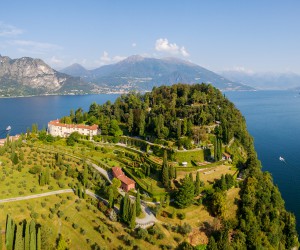
The Park of Villa Serbelloni Sightseeing
Villa Serbelloni is now a Grand Hotel. Its park is one of the best of the Lake. The luxurious Italian-style gardens has a bounty of Mediterranean and subtropical plants, which flourishes in the pleasant microclimate around the lake. The lower part of the garden is an informal parkland planted with olives trees and Italian Cypresses. The upper garden is mainly woodland. The part of the garden near to the house consist of three curved terraces on which there are flowering plants and shrubs. A separate small garden has a fountain dedicated to Cecilio Plinio.
The park, the lake's largest, extends all over the entire promontory to the small town's mount which offers a splendid view of the two branches of the Lake. The Neo-classical Villa Melzi can be seen from the lake, from extremely sober and elegant forms, realized between the 1808 and 1810 and based on Giacomo Albertelli's project for the Count Francesco, vice president and Chancellor of the Kingdom of Italy. Described by Stendhal, this noble residence hosted many famous guests: the Emperors Francesco I and Ferdinand of Austria to the musician Liszt. Worthy of mention as well is Villa Trivulzio, built in the 18th Century and restored a Century later with its grand English-style park, and Villa Trotti, in its neo-Gothic remake with Moorish decorations and with rarities that enrich the park.
The Villa is owned by the Rockefeller foundation and is not open to the public. You can take a guided tour of the park at a price of 9 euro from April through October, Tuesday to Sunday (no tours when it's raining) two tours per day: at 11 am and 3.30 pm, tour lasts 1.5 hours.
Winston Churchill, Roosevelt, the Rothschilds, J.F. Kennedy, Clark Gable, Robert Mitchum and Al Pacino have all strolled through the rooms and lakeside gardens of the Grand Hotel Villa Serbelloni. Gianfranco Bucher is their of a family, who for five generations has made the high class hotel's hospitality his life 's ambition.

Walls, Gattoni Tower and Gate Tower Sightseeing
The walls of Como, built for the fist time by order of Julius Caesar, were part of a complex defensive structure to cover the entrances to Milan and Po Valley from the Central Alps, which included, among others, the Castle Baradello, the Comacina Island fortification and the castles of Bellinzona.
Gattoni Tower, formerly know as Tower of Porta Nuova, was rebuilt by Frederick Barbarossa, together with the other two towers and was acquired in the late 1700s by Giulio Cesare Gattoni, a keen natural scientist, who opened a physics laboratory and there settled its scientific collections. Alessandro Volta, a friend of Gattoni, was often there to study and perform experiments that led to his great invention of the century: Pila.
Tower Gate and Victoria are the oldest (1192) and most imposing medieval towers still standing. Standing at the height of 40 meter, its features two outer arches, the north side has a single tube with a great arch surmounted by four rows of double windows.
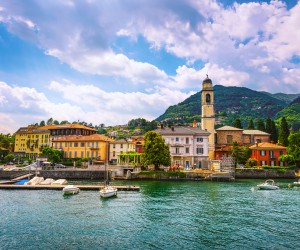
Cernobbio Sightseeing
Cernobbio is a comune (municipality) in the province of Como, Lombardy, northern Italy. It is located about 40 kilometres (25 mi) north of Milan and about 2 kilometres (1 mi) northwest of Como, on the border with Switzerland and near the Lake Como. The highest peak is the Monte Bisbino, at 1,325 m.
Cernobbio borders the following municipalities: Blevio, Breggia (Switzerland), Como, Maslianico, Moltrasio, Vacallo (Switzerland).
Cernobbio received the honorary title of city with a presidential decree on May 24, 2005.
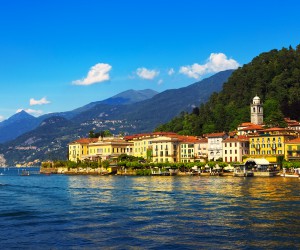
Bellagio Sightseeing
Bellagio is called the pearl of Lake Como. It is undoubtedly the most famous resort on the lake. For centuries, its scenic location has enchanted artists and writers, not only from Italy, but also from abroad. It is situated on the tip of a headland that divides the lake into the two legs of Como and Lecco.
The town stretches along the coast and part of it goes up the slopes of the promontory.
Because of its location it has a great variety of views; indeed, it offers a good view of whore lake. On the northern horizon one can see the Pre-Alps.
Some of the best views can be seen from the park of Villa Serbelloni and from the top of Monte San Primo. On a particularly clear day, on ecan make out the Alps, from Mont Blanc to the Ortles, and the Madonnina on top of the Duomo of Milan.
The historic center situated at a higher level dominated by the Romanesque Basilica of San Giacomo (enlarger in the Baroque Age) and the more recent lake-front arcade are all preserved intact.
Among the aristocratic villas let's remember Villa Serbelloni. Fist was a castle, then a country residence and transformed into villa at the end of the 15th century. Later once again restructured in the 17th and turned into a hotel during the last decade of the 19th century. It is now the appointed headquarters of conventions and study tours.
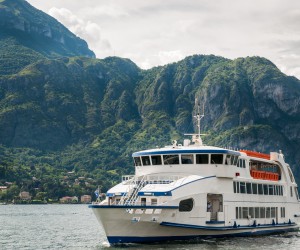
Boat Trip in Como Sightseeing
Its origin goes back to the Ice Age.
It has an inverted Y shape with the two branches that head south towards Lecco and south west towards Como.
Thanks to a clement climate that favored the arboreal development, the Lake was inhabited since the proto-historic era.
Then the Roman colonization took place, and it culminated with the establishment of Como as the area was especially important either for the defence of the lowland territories as well as a connection to the lands beyond the Alps.
In the same period the reputation of the Lake began to spread, its shores and settlements began to rise.
Among the early bards of the virtue of the Lake were the Latins, Cassiodoro, Pliny the Elder, Pliny the Younger (natives of Como) and Strabone.
Later on in time were added these voices, that of Paolo Diacono, of Leonardo and Benedetto Giovio.
The international acclaim of the Lake arrived in any event between the 18th and the 19th Centuries, with first the triumph of the "villa civilization", and then with the development of the tourist élite.
Lake Como as a result became the obligatory stop for travellers and writers visiting Italy: those who wrote about it among the others Bourget, De Musset, Longfellow, Stendhal and Flaubert.
The most well-known passage are the celebrated opening lines to the "Promessi Sposi" "The Betrothed": That branch of lake of Como that turns at midday…", with which Manzoni immortalized the Lecchese versant.
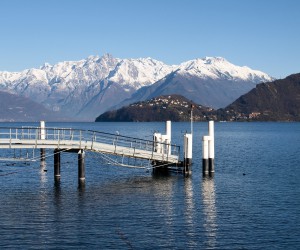
Menaggio Sightseeing
The town Menaggio is situated in the heart of Lake Como, on its western shore, at the beginning of a valley that connects Menaggio with lake Lugano. Its central position makes it a lively town. Already in the first half of the 18th century it was discovered by the first tourists, enchanted by the beauty of the landscape and the mild climate, and the grand hotels like Grand Hotel Victoria and the luxury villas like Villa Mylius Vigoni and Villa Garovaglio Ricci were built.
The town Menaggio consists in a centre and three hamlets Loveno, Nobiallo and Croce and has a total of about 3200 inhabitants. Menaggio is of ancient origins and in its centre and in its hamlets there are many interesting monuments which recall Menaggio's importance throughout the ages. The heart of the "old" town is gathered around Piazza Garibaldi close to Menaggio's harbour. In Via Calvi among fashionable shops you can see, on the facade of the church of S. Marta, the memorial plaque of Minicio Exorato, a notable of the Roman empire. Narrow cobble stoned alleys lead up to the area called castello. The castle, of which remain impressive perimetric walls was destroyed in 1523. The historic and artistic itinerary through Menaggio will help discover the town. Children will enjoy the amusing puzzle tour through Menaggio.
Menaggio is a popular destination, particularly for holidaymakers keen on outdoor activities. There is an eighteen-hole golf course at about 5 km from town, and plenty of good walking in the area, from easy strolls to tough mountain hikes, as well as opportunities for swimming, water-skiing, mountain-biking and riding.
The higher part of the town has medieval aspect featuring narrow alleys, steep stairs and stone buildings. The old and "new", the shops, restaurants, cafes, public squares and alleyways, the tree shaded lake shore promenades bordered by flowers, and the well kept villas form a wonderful and serene place to see.
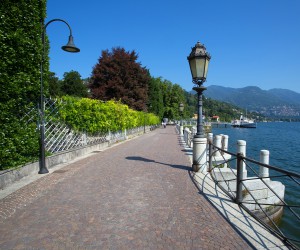
Passeggiata Villa Olmo Sightseeing
The walk was built by Como in 1959: originally the villas had direct access to the lake, now they have no more, and the curiosity of tourists can peek through the gates of the gates and in many cases, as many of the public property villas Access it freely.
Most of the villas were built during the domination of the Habsburgs in the 18th century, which confiscated those lands to the convents to sell them, at fairly low prices, to the noble families of the place.

Diga Foranea Piero Caldirola Sightseeing
Diga Foranea Piero Caldirola is a very nice place where you can walking and admire the view of the Lake and hills. There is the new monument Life Electric dedicated to Alessandro Volta.
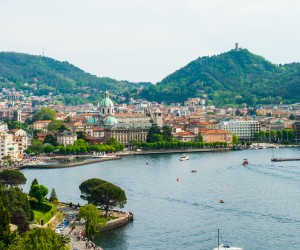
Lungo Lago Sightseeing
Lake Como is a lake of glacial origin in Lombardy, Italy. It has an area of 146 square kilometres (56 sq mi), making it the third-largest lake in Italy, after Lake Garda and Lake Maggiore. At over 400 metres (1,300 feet) deep, it is one of the deepest lakes in Europe, and the bottom of the lake is more than 200 metres (660 ft) below sea level. During the walking you can see a very nice view of the lake, enjoy the promenade in the sunny days and share good moments with the person that you love.
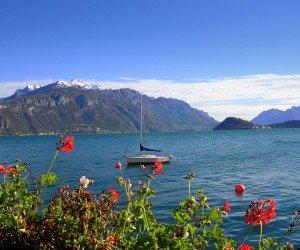
Passeggiata sul Lago di Como Sightseeing
The area of Lake Como has an extremely varied nature that creates panoramas of extraordinary beauty, important for local tourism as well as artistic monuments and history.
Lake Como is an ideal place for relaxing, cultural or sports holidays, suitable for all ages and available in all seasons.

Transportation
Transportation Hubs, Train Stations, Metro, Taxi, Boat, Airports, Bus Stations, Cable Railway
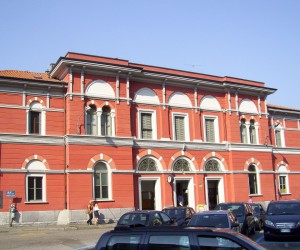
Como Lago Station Transportation
TRENORD S.r.l. employs over 4,000 people and is the only company in Italy that deals exclusively with public transport by rail of a single region. Lombardy is the most "mobile" area in Italy, where more than 650,000 people - approximately 180 million passengers per year - travel by train every day.
TRENORD is the first operator to specialise in local transport by rail. It manages the suburban and regional rail service, the airport service Malpensa Express (from Milano Cadorna, Milano Centrale, Milano Porta Garibaldi) and the Como-Chiasso and Malpensa-Bellinzona cross-border service, providing a total of 2,300 journeys per day, predominantly towards the hub of Milan.
The company was established on 3 May 2011 merging the experience, know-how and facilities of Trenitalia (Regional Division for Lombardy) and FNM Group (LeNord) - each of which has a 50% holding - in order to streamline and optimise the rail service in Lombardy.
The development of a modern, efficient and sustainable transport system is an overriding priority and a challenge that the Lombardy Region at the top of its agenda. Indeed, its status as both sponsor and body of primary control for local public transport makes the regional authority guarantor of the service.
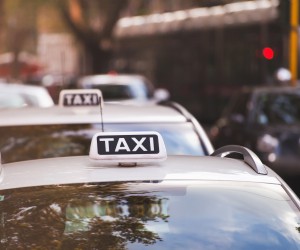
Taxi Como Transportation
Taxi Como offers a taxi service for commuting and suburban 24 hours on 24 and 7 days out of 7, including holidays. Taxi Como also offers airport transfers to and from the airports of: Malpensa (Milan), Linate (Milan), Orio al Serio (Bergamo), Agno (Lugano, CH).
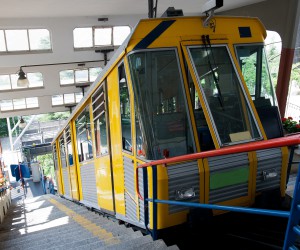
Funicolare Transportation
In 1894 the funicular Como-Brunate is opened, symbol of the public transport development in that period, when every centre in the Province was linked with the provincial capital through a series of public transport lines.
It was the period of industrial development and the beginning of what would later become “mass tourism".
In 1911 the traction system is changed from steam to electricity.
In 1912 the "cannon" is installed, firing a salute every day at noon (reactivated in 1994 after 20 years inactivity).
In the years 1934/35 the plant is completely revamped, including the total rebuilding of the Brunate station. In 1951 a further changing of vehicles is carried out.
At the end of the '60s, the private transport by car puts public transport in a difficult position, as it gradually becomes clear in the second half of the XX century.
In the '70s in Como, as in other areas of the country, private transport companies cannot control losses any more.
The local bodies around Como (Municipalities and Province) decide to react to such a situation establishing a consortium that will manage the suburban lines in the Como province already in concession to the companies STECAV, SALVI, BARADELLO, GRATTONI and DELL'OCA.
For a long time such a consortium will also manage the funicular plant whose property was transferred from Società Anonima Funicolare Como/Brunate, (whose reference shareholder was Earl Cesare Bonacossa) to the Region of Lombardy in 1981.
During the period of entrusted management the C.P.T. Consortium carried out the adaptation of the plant to the new security and technology needs.
As from July 2005 the management of the Como/Brunate Funicular is entrusted - following the enforcement by the Como Municipality of the procedures for deregulating the public transport services sector - to a joint Society whose head office is in Como (Consorzio Mobilità Funicolare & Bus). Within such a framework the operation management of the Como - Brunate funicular is entrusted to Azienda Trasporti Milanesi S.p.A.
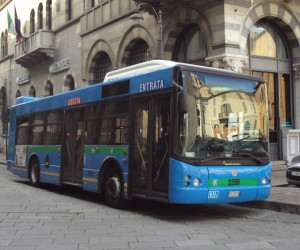
Como Bus System Transportation
ASF Autolinee is a public passenger transport organisation in Como and its province.
The company manages public passengers transport services:
for the Province of Como, through the STECAV consortium (www.stecav.it), whose service is carried out by ASF and FNMA
in the City of Como and in its urban area, through the COMO FUN&BUS consortium (www.funandbus.it), operated by ASF for the bus service and by A.T.M. for the cable car service.
ASF Autolinee plays an important function in supporting social development and the general well-being of the community, ensuring an extensive network of lines and connections.
Thanks to its 500 employees and 310 buses, ASF Autolinee transports some 20 million passengers and operates over 12.6 million kilometers every year.
The company has 21 depots and garages. ASF also manages the Bus Terminal located in Piazza Matteotti, Como, which is an important interchange point between the main urban and extra-urban lines, railways (Como-Lago station), lake navigation and cable car services.

Hospital
Hospitals, Pharmacies, Medical Centers
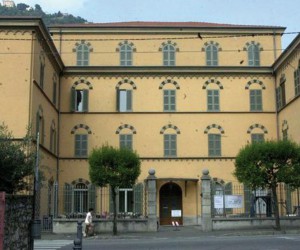
Ospedale Valduce Hospital
From the first "Casa" of welcome to Via Vitani, wanted by the Foundress Giovannina Franchi in 1853 to assist the sick of Como, the Congregation of the Nurses Nurses of the Addolorata is still witness to that assistance that, keeping in step with the evolution Medical-scientific and adapting to the new needs of "health and well-being", always pursues its key objective: respect for the dignity of the person.
Telephone number: +39 031 324111

Police & Law
Police Stations, Court House, Lawyers

Place to Hangout
Where Locals Like to Visit, Common Place to Hangout, Public Spaces
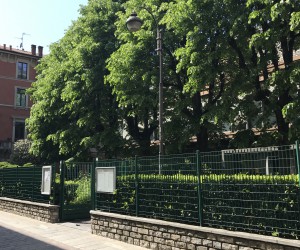
Biblioteca Comunale di Como Place to Hangout
It is the leading library of Como's Library System and the largest and oldest in the city, its first nucleus dates back to the mid-17th century.
It has a wealth of about 400,000 of manuscripts, prints and multimedia documents.
It is of a general nature and is constantly updated in all fields of knowledge.
Access to the Library is free and free, and the property offers spaces and services to meet the needs of citizens of all ages.
Most of its library assets are stored in the stores and accessible through "card" and "electronic" catalogs. Exceptions are the kids room and the consulting room, the open shelves where the documents are straightforward and directly accessible.

Sports Area
Sports Area, Sports Facilities, Stadium, Sport Centers
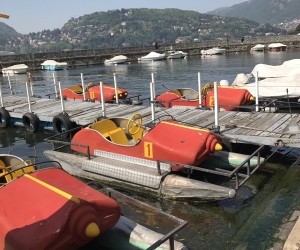
Pedalò Lake Como Sports Area
Since 1892, the company Tasèll offers tourists rent of motorboats, taxi boats and charter boats, on Lake Como, for transfers and cruises, to discover Lake Maggiore by travelers and writers of Romanticism. Starting from Como or the other attractions along the Lake, such as the Grand Hotel Villa d'Este in Cernobbio, there are excursions to Comacina Island, Tremezzo, Bellagio, Villa del Balbianello, Varenna, Menaggio etc.
The lake seen from the lake allows you to grasp the magic of the places and to realize the uniqueness of these landscapes, scattered with baroque or neoclassical villas, lush parks, small Romanesque churches and medieval villages lying on the banks or perched on the slopes of the hills. In the spring, the gardens slope to terraces towards the lake covered with azaleas and rhododendrons in bloom.

Entertainment
Entertainment, Cinema, Theater, Concert Halls

Garden
Gardens, Places to Stroll, Places to Relax, Parks, Parks for Kids
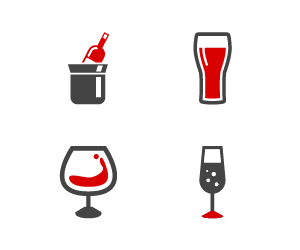
Pub
Pubs, Evening Drinks, Places to Drink
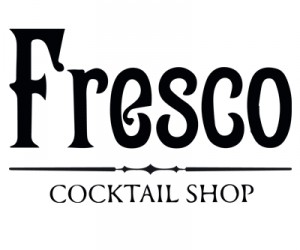
Fresco Cocktail Shop Pub
Fresco Cocktail Shop offers special Cocktails with typical Italian fruits, classics Cocktails and different proposal of Cocktails every month.

Cube Como, Restaurant & Cafè Pub
Cube Como, Restaurant & Cafè is a restaurant, lounge bar near the public garden of Tempio Voltiano, beautiful location near the Lake.
Perfect for Happy Hour and for different type of drinks.

Il Birratrovo Beer Shop Como Pub
The Beershop in the city center of Como, Birratrovo offers more than 400 different excellent Beer label.
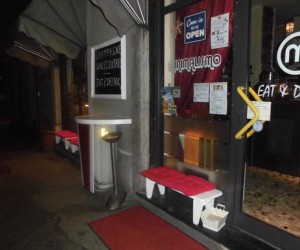
Minimalismo Living Room Pub
Minimalismo Living Room offers different type of drinks, wine and more. Excellent for Happy Hour.
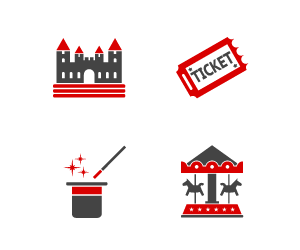
Attraction
Attractions, Circus, Playgrounds, Touristic Entertainment

Hostel
Hostels and Low-Cost Accomodation Possibilities
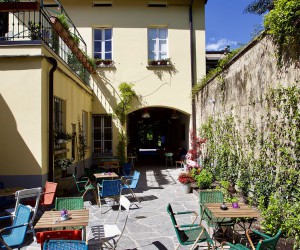
Ostello Bello Lake Como Hostel
The Hostel is very near the Lake and the Tempio Voltiano, these are the information: 24 hours reception and bar, Key Card access, Pets are more then welcome in private rooms, 69 beds, Air Con in all rooms and common areas, Lockers in every shared rooms, Free WI-FI in every room and common area.
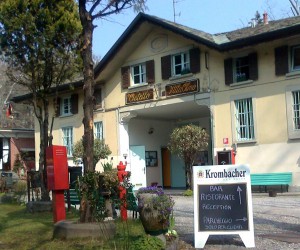
Ostello Villa Olmo Hostel
The Hostel Villa Olmo is a historical hostel of the city of Como. Over 50 years the hostel welcomes travelers from around the world.
It is the ideal location for those who want to enjoy the beauty of the lake and mountains, while remaining in contact with the city.
Located in what was once the stables of Villa Olmo a few steps from the lake - in the park of the eighteenth-century villa- is located only 15 'walk from the city center and 3 km from Switzerland. Large garden, free parking, multilingual staff.
Our hostel is member of Hostelling International, of the Italian Youth Hostels Association and hostel’s network in Lombardy.
The hostel has been renovated and is ready for the great world event of Expo 2015.

Shopping
Shopping Centers, Shopping Malls, Best Streets to Shop
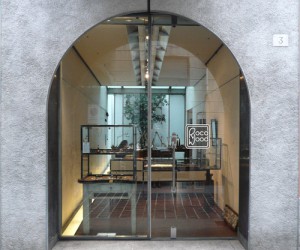
Roca Wood, Jewelry Store Shopping
Roca Wood was founded in 2007 by Mario Roca and Fiona Wood and is located in the historical city center of Como.
All phases of design and craftsmanship are in house and the pieces are sold exclusively in our shop.
We create custom made Jewelry and fine jewelry commissions,
also from your own design or idea. Our services include high quality restyling and reparations on antique and modern jewelry.
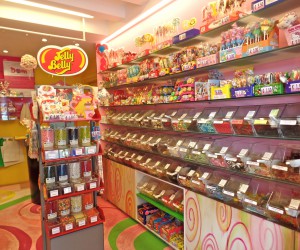
Le Mille e una Mella, Candy Shop Shopping
Le Mille e una Mella is a Candy Shop opened in 2008, it is a space full of creativity, you can find: original cakes, little trees, bouquet, placeholder...all made by candies!
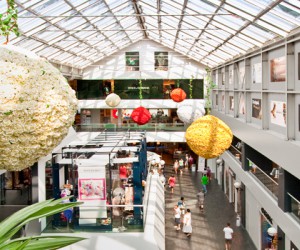
Fox Town Shopping
If you like shopping, do not miss FoxTown Factory Stores, the temple of luxury and elegance where 160 stores of the most prestigious brands for men’s, women’s and children’s clothing, sport articles, household goods and accessories are under the same roof. A successful combination of quality and low prices where manufacturers offer their surplus and garments from the previous season at prices discounted from 30% to 70% and where the dream of discreet and advantageous shopping becomes true. 1200 parking spaces, a Casino and 7 food corners help turn a shopping spree into an unforgettable day.
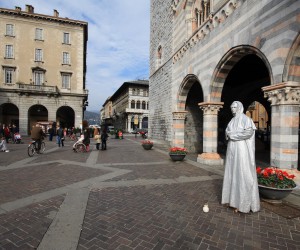
Piazza Duomo Shopping
Piazza del Duomo is in the historic center of Como you can see the Civic Tower, the Broletto and the Cathedral. There are also many cafes, clothes shops, cosmetics shop and the famous franchise COIN.
It's the heart of Como, where you can reach other road with many restaurants, cafes and great variety of shops.

Piazza San Fedele Shopping
Piazza San Fedele is in the pedestrianized center of Como, near the city's shopping streets and within easy walk to the lake and several restaurants.
There are two cafes to stop pleasantly during a visit to the city, a library, a beautiful shop of articles for the house, several other clothing stores, a fur, a children's store, shoe, silk and telephony. Very nice it is to see, in a corner of the square in front of the basilica, two buildings (one right on the corner and the other above the library) from the Middle Ages which retain their original state and outside their large wooden beams within.
On Saturday then there is a lovely market of handicrafts, jewelery, leather and much more which attracts many people and tourists.
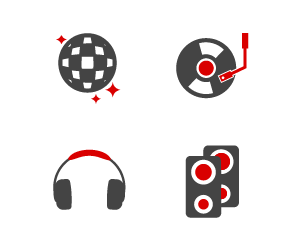
Night Club
Night Clubs, Disco, DJ Club, Live Music, Night Entertainment

Cafe Bar
Cafe Bar, Places to Drink Cafe, Patisserie

Ristorante Bar Giuliani Cafe Bar
The Bar Giuliani is a nice place near the Lake that offers different types of dishes and beverage. Bar Giuliani prepares lunch, dinner and Happy Hours.
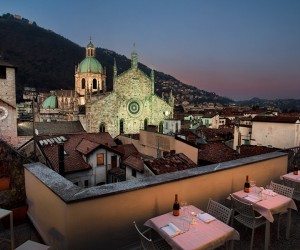
Loft Cafe Bar
Loft Esclusive is an elegant and modern place in the heart of the town (5th floor Coin dept. store), which offers a spectacular view on the Duomo and the historic center. An evening on the terrace overlooking the Cathedral and city lights is an experience not to be missed when visiting Como. Loft Como offers also breakfast, lunch, events planning. Booking advised.

Beauty & Health
Beauty Centers, SPAs, Health Centers
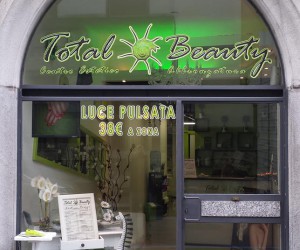
Total Beauty Como Beauty & Health
Aesthetic Center available every day except Saturday and Sunday for Pulsed Light, Nail Reconstruction, Tanning Lamps, Aesthetics and Osteomassage. Only with appointment.


